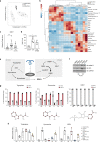mTOR regulation of metabolism limits LPS-induced monocyte inflammatory and procoagulant responses
- PMID: 36028574
- PMCID: PMC9412771
- DOI: 10.1038/s42003-022-03804-z
mTOR regulation of metabolism limits LPS-induced monocyte inflammatory and procoagulant responses
Abstract
Translocated lipopolysaccharide (LPS) activates monocytes via TLR4 and is hypothesized to increase cardiovascular disease risk in persons living with HIV. We tested whether mTOR activity supports LPS-stimulated monocyte production of pro-inflammatory cytokines and tissue factor (TF), as it propels the inflammatory response in several immune cell types besides monocytes. However, multi-omics analyses here demonstrate that mTOR activates a metabolic pathway that limits abundance of these gene products in monocytes. Treatment of primary human monocytes with catalytic mTOR inhibitors (mTORi) increased LPS-induced polyfunctional responses, including production of IL-1β, IL-6, and the pro-coagulant, TF. NF-κB-driven transcriptional activity is enhanced with LPS stimulation after mTORi treatment to increase expression of F3 (TF). Moreover, intracellular NAD+ availability is restricted due to decreased salvage pathway synthesis. These results document mTOR-mediated restraint of the LPS-induced transcriptional response in monocytes and a metabolic mechanism informing strategies to reverse enhanced risk of coagulopathy in pro-inflammatory states.
© 2022. The Author(s).
Conflict of interest statement
The authors declare no competing interests.
Figures





References
Publication types
MeSH terms
Substances
Grants and funding
LinkOut - more resources
Full Text Sources
Molecular Biology Databases
Miscellaneous

